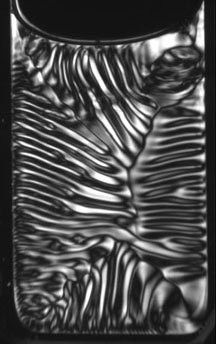
|
August 3, 2006 |
Patterns in Nature
The Shape of Life: Research Sheds Light on How Cells Take Shape
Brown University physicists have identified a surprising force in pattern formation – physical force. Results of their work shed important light on how life takes shape inside cells and are published in the Proceedings of the National Academy of Sciences. | |||
|
Brown University Home |
PROVIDENCE, R.I. — How life takes shape is a mystery. Butterfly or baby, cells organize themselves into tissues, tissues form organs, organs become organisms. Over and over, patterns emerge in all living creatures. Spiders get eight legs. Leopards get spots. Every nautilus is encased in an elegant spiral shell. This phenomenon of pattern formation is critical in developmental biology. But the forces that govern it are far from clear. Alan Turing, father of modern computer science, suggested that the basis for pattern formation was chemical. New research conducted at Brown University and published in the Proceedings of the National Academy of Sciences supplies another surprising answer: Physical, as well as chemical, forces can dictate pattern formation.  Powerful forces on a very small scale In a two-year study, Brown physicists James Valles and Jay Tang puzzled over the patterns created by proteins called microtubules. Shaped like long, skinny straws, these proteins are puny – they measure only about 250 atoms wide – but play critical roles in the body. Microtubules help cells divide. They also act as scaffolds, giving cells their shape, and serve as train tracks of sorts, moving important bits like chromosomes and mitochondria around inside of cells. As microtubules multiply, they form patterns that can be seen by the naked eye. The pattern is a series of waves that look a bit like zebra stripes. How, Valles and Tang asked, do they form? Working with graduate students Yifeng Liu and Yongxing Guo, Valles and Tang grew their own microtubules then studied them under three types of microscopes. After two years of work, they solved the mystery. Chemical bonding and mechanical instability were responsible for the stripes. In the first stage of the process, the microtubules line up uniformly, like pickets in a fence. As the microtubules continue to grow, they clump together in bundles of 200 to 300. Then these bundles buckle. Valles and Tang believe that the buckling occurs because, as microtubules grow, they create energy and generate force. Then the bundles buckle to relieve compression stress. “Think of it like the ‘wave’ that fans create during a soccer game. One bundle buckles, then it sets off another bundle, then another bundle, until you get a sea of undulating stripes,” Valles said. “What’s exciting is that this finding may provide insight into how the shapes that make up the human body are created.” Tang agreed: “Pattern formation is critical to the creation of life. Now we really understand the mechanism behind this type of pattern in microtubules. Force is the key.” The National Aeronautics and Space Administration funded the research. The paper is available online and in pdf format at www.pnas.org/cgi/content/full/103/28/10654. ###### | |||